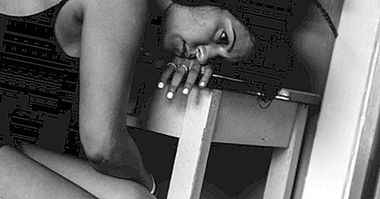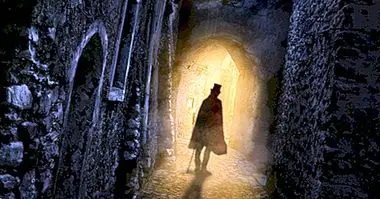Homicidal sleepwalkers: 5 unusual cases of accidental death
Throughout the world there is a large number of people suffering from sleepwalking; it is known the fact that These people roam the house and sometimes perform complex actions , and even household chores, being unconscious, automatically.
As a general rule it is a problem that can be annoying and generate confusion and fright for those who observe it; In the worst case, the proximity of windows or doors facing the street can lead to dangerous situations.
However, sometimes the activities that are carried out are more strange: there are painters who are only able to create in a state of somnambulism, or people who come to commit crimes in that state, such as rapes or murders. In this last case we are talking about homicidal sleepwalkers .
- Maybe you're interested: "The 3 main types of homicidal motivation in murderers"
sleepwalking
Before going into a detailed discussion of what a homicidal sleepwalker entails, it is necessary to briefly review what exactly is sleepwalking .
Sleepwalking is defined as a sleep disorder included within the parasomnias , or behavior disorders during sleep, which does not alter the amount of sleep and total wakefulness. In the case of sleepwalking we find subjects who carry out motor activities in a state of unconsciousness, generally during phases 3 or 4 of non-REM sleep. These actions are usually limited to getting up and walking, sometimes even with your eyes open.
It is a relatively common disorder in the population, especially during the stage of child development. There is an alteration in sleep cycles , specifically between the transition from non-REM sleep to REM. The motor system is not paralyzed, as would happen in most cases, and the body acts without the conscience can take charge of the situation.
- Related article: "The 7 main sleep disorders"
From sleepwalking to homicide
It is in this context that anomalous behaviors may appear. And is that the motor system is active while consciousness is only partly with what could come to be carried out different actions alien to their own will. And depending on the case this could generate violent behavior in people subject to great stress, frustration and generate aggressive responses.
A homicidal sleepwalker is a person who commits a homicide in a non-vigilant state : that is, being asleep. The subject would not be aware of the situation and this would be alien to his will and control. As in most cases, the sleepwalker does not remember what happened later, although he may retain some fragmented picture of the situation.
It is a phenomenon that is not very frequent, but technically possible (brain alterations have been proven during sleep in some studied subjects) and in fact it has happened several times throughout history (there are more than fifty cases) registered). Now, it is necessary to reiterate that they are very rare cases: most somnambulists do not commit this type of acts and they just walk around.
- Maybe you're interested: "Night terrors: panic during sleep"
Some known homicidal sleepwalkers
Although it may seem an excuse used to request the imputability or be used as mitigating in a trial, the truth is that there have been times when it has been ruled that a murderer acted asleep or in a state of semi-conscience, resulting in the subject declared innocent. Some of the cases of homicidal sleepwalkers that have been registered in this regard below.
1. Robert Ledru
The case of Robert Ledru is one of the oldest of which there is evidence. In 1887, this chief inspector of the French police (considered one of the best French investigators of the 19th century) was sent to investigate a murder that occurred on the beach of Le Havre. The victim was André Monet, who had been shot dead. There was no apparent motive, and the subject was not known in the area and kept all his belongings.
The only clue that was found besides the bullet (which belonged to a type of weapon very common at the time) was a series of tracks near the body. When the inspector approached he could observe that in these tracks the lack of thumb in the right foot was appreciated . After a moment when he seemed frightened, he ordered a plaster mold to be removed from the prints, which he later examined. After this examination he reported that he already knew who the murderer was.
Once in police station Ledru surrendered: the morning after the murder he was surprised to notice that his socks and clothes were wet, and after analyzing the crime scene he observed that his gun was missing a bullet of the same caliber as the one that killed the victim . And the most remarkable thing: he lacked the thumb of the right foot, corresponding the tracks found with his.
The inspector stated that he was not aware of having committed the crime, probably during the dream. But nevertheless, He requested to be detained on the grounds that it could be a danger to security of other citizens. To verify this fact, it was decided to lock him in a cell with a pistol with blank bullets. Once the agent fell asleep, he got up and started firing at the guards who watched him before lying down again to continue sleeping. It was considered true and it was decided that he would spend the rest of his life in a farm on the outskirts, under medical supervision.
2. Kenneth Parks
One of the most famous and known cases is that of Kenneth Parks, in 1978. This man, a compulsive gambler with numerous debts, left his house to take the car and go to his in-laws' house. Once there, he killed his mother-in-law with a bar and strangled his father-in-law. After that he drove to a police station and gave himself up. The event has the peculiarity that during the whole process, the subject was asleep .
Kenneth, who had been sleepwalking for a long time, was analyzed with the technique of encephalography and the measurement of his sleep waves reflected that he changed sleep cycles quickly and abruptly. Being in a period of not deep sleep, he could commit the acts without real awareness of carrying them out. He was declared innocent.
3. Simon Fraser
Another known case is that of Simon Fraser, who while asleep dreamed that a child was trying to kill his son . Apparently trying to protect him, he attacked the creature, and shortly thereafter regained consciousness, to discover with horror that he had killed his son, crushed his head against the wall.
Fraser had a previous history of violent actions during sleep; He had attacked his father and his sister, and had even self-harmed while asleep. Once he got his wife out of bed by the legs, dreaming that there was a fire. After a series of studies the subject was finally considered innocent and acquitted, although it was established that he should sleep separately from other people in a locked room.
4. Brian Thomas
One more case of a homicidal sleepwalker is found in Brian Thomas, a man with a long history of parasomnias that in 2009 he strangled his wife while she slept. This Brit had been under stress, having argued with some young people at a time when he and his wife were celebrating the conclusion of a cancer treatment. After lying down, Thomas dreamed how one of the young people entered his room and placed himself on his wife, so he rushed against the supposed young man and fought with him. Soon after he would wake up, to observe that during his sleep he had killed his wife. He was declared innocent.
5. Scott Falater
A case of a presumed homicidal sleepwalker is found in the figure of Scott Falater, who in 1997 stabbed his wife 44 times, after which he would throw her into the pool and keep the bloodstained dress in the car. After being arrested, Falater he could not find an explanation for the acts that he considered based on the tests he should have carried out .
An expert in sleep disorders examined the murderer and ruled that it could be possible that the perpetrator had committed them while sleepwalking. However, it was considered that his actions were excessively complex to have been done while asleep and without planning and after being convicted he was sentenced to life imprisonment.
Causes?
Before the examples that we have seen, it is possible to ask itself what can cause that a person kills to another being unconscious.
As we have seen, somnambulism it is produced by a mismatch in the activation and inhibition of different brain regions that are happening throughout the different phases and cycles of sleep. Specifically, the problem is found in the third and fourth phase of sleep (corresponding to deep sleep of slow waves) and the subsequent step to REM phase. However, the causes of this fact are unknown.
It is known that sleepwalking has some relation to the level of psychosocial stress . In adults, mental and organic disorders may also appear, or as a consequence of substance use. One factor that may have some influence when it comes to altering sleep patterns is the presence of factors such as stress or depression. In addition, in almost all cases of homicidal sleepwalkers it has been seen how the aggressor suffered or had suffered great levels of stress or tension and some type of emotional conflict prior to the act.
For example, in the case of Ledru, the inspector was under great stress and I suffered a certain level of depression and fatigue from their work , in addition to having syphilis for a decade. Something similar happened with Parks (with economic problems and gambling), Thomas (a previous fight and the stress situation generated by the cancer of his wife) and Fraser.It is also common for them to have a long history of parasomnias.
But being unconscious does not explain why in some cases this somnambulism ends up degenerating into violent behavior or how it can lead to murder or homicide. It is speculated that in these cases the prefrontal may be inactive and not govern proper behavior and personal morals, while the amygdala and the limbic system remain active and generate an aggressive response.
The great doubt
Taking into account the above definitions and the cases shown, a question may appear that may seem obvious: are we facing real cases of murders committed unconsciously during sleep, or in an attempt to justify or get declared innocent? In the majority of cases it has counted on the advice of experts in sleep and their disorders and sleep registries have been carried out to verify the possible existence of this problem, as well as the brain functioning during sleep.
The answer to this question is not simple: as with other mental disorders, you have to take into account the level of awareness of the accused at the time of committing the crime and if at that moment his condition generated his behavior. This can only be known indirectly, and with a margin of error to be taken into account.
In fact, in some of the cases cited there has been a great controversy: the case of Brian Thomas, for example, has raised in some experts the doubt of whether he was really unconscious (strangling someone requires a lot of strength and a situation of resistance or struggle on the part of the other person), and Scott Falater's conviction that raised controversy when considering the expert who was not aware but who applied due to the jury's consideration that his acts were too detailed to be performed without any conscience.



















